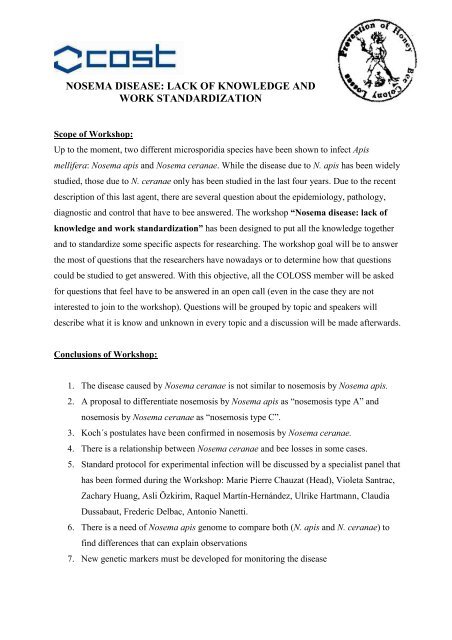Nosema Disease: Lack of Knowledge and Work ... - COLOSS
Nosema Disease: Lack of Knowledge and Work ... - COLOSS
Nosema Disease: Lack of Knowledge and Work ... - COLOSS
You also want an ePaper? Increase the reach of your titles
YUMPU automatically turns print PDFs into web optimized ePapers that Google loves.
NOSEMA DISEASE: LACK OF KNOWLEDGE AND<br />
WORK STANDARDIZATION<br />
Scope <strong>of</strong> <strong>Work</strong>shop:<br />
Up to the moment, two different microsporidia species have been shown to infect Apis<br />
mellifera: <strong>Nosema</strong> apis <strong>and</strong> <strong>Nosema</strong> ceranae. While the disease due to N. apis has been widely<br />
studied, those due to N. ceranae only has been studied in the last four years. Due to the recent<br />
description <strong>of</strong> this last agent, there are several question about the epidemiology, pathology,<br />
diagnostic <strong>and</strong> control that have to bee answered. The workshop “<strong>Nosema</strong> disease: lack <strong>of</strong><br />
knowledge <strong>and</strong> work st<strong>and</strong>ardization” has been designed to put all the knowledge together<br />
<strong>and</strong> to st<strong>and</strong>ardize some specific aspects for researching. The workshop goal will be to answer<br />
the most <strong>of</strong> questions that the researchers have nowadays or to determine how that questions<br />
could be studied to get answered. With this objective, all the <strong>COLOSS</strong> member will be asked<br />
for questions that feel have to be answered in an open call (even in the case they are not<br />
interested to join to the workshop). Questions will be grouped by topic <strong>and</strong> speakers will<br />
describe what it is know <strong>and</strong> unknown in every topic <strong>and</strong> a discussion will be made afterwards.<br />
Conclusions <strong>of</strong> <strong>Work</strong>shop:<br />
1. The disease caused by <strong>Nosema</strong> ceranae is not similar to nosemosis by <strong>Nosema</strong> apis.<br />
2. A proposal to differentiate nosemosis by <strong>Nosema</strong> apis as “nosemosis type A” <strong>and</strong><br />
nosemosis by <strong>Nosema</strong> ceranae as “nosemosis type C”.<br />
3. Koch´s postulates have been confirmed in nosemosis by <strong>Nosema</strong> ceranae.<br />
4. There is a relationship between <strong>Nosema</strong> ceranae <strong>and</strong> bee losses in some cases.<br />
5. St<strong>and</strong>ard protocol for experimental infection will be discussed by a specialist panel that<br />
has been formed during the <strong>Work</strong>shop: Marie Pierre Chauzat (Head), Violeta Santrac,<br />
Zachary Huang, Asli Özkirim, Raquel Martín-Hernández, Ulrike Hartmann, Claudia<br />
Dussabaut, Frederic Delbac, Antonio Nanetti.<br />
6. There is a need <strong>of</strong> <strong>Nosema</strong> apis genome to compare both (N. apis <strong>and</strong> N. ceranae) to<br />
find differences that can explain observations<br />
7. New genetic markers must be developed for monitoring the disease


